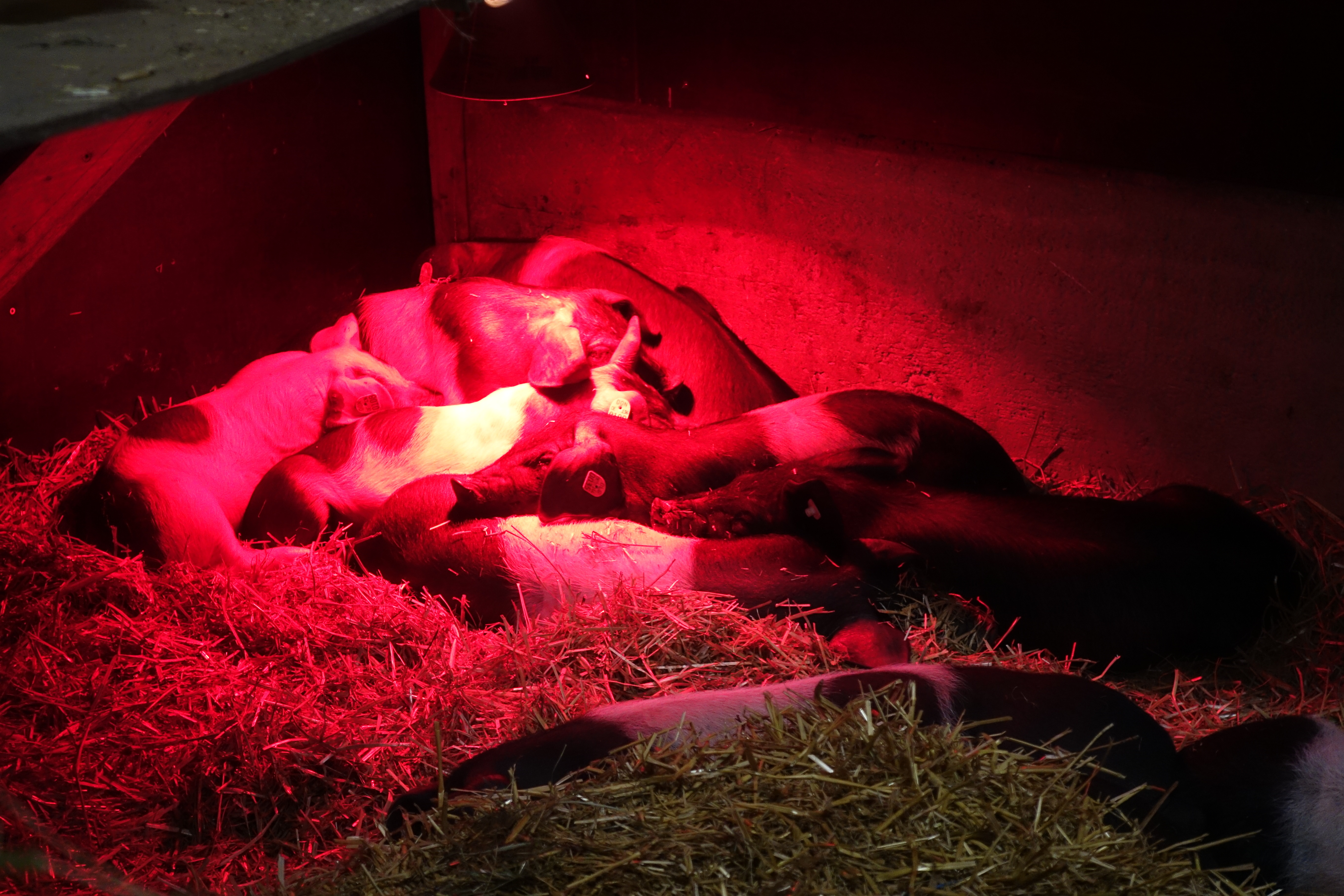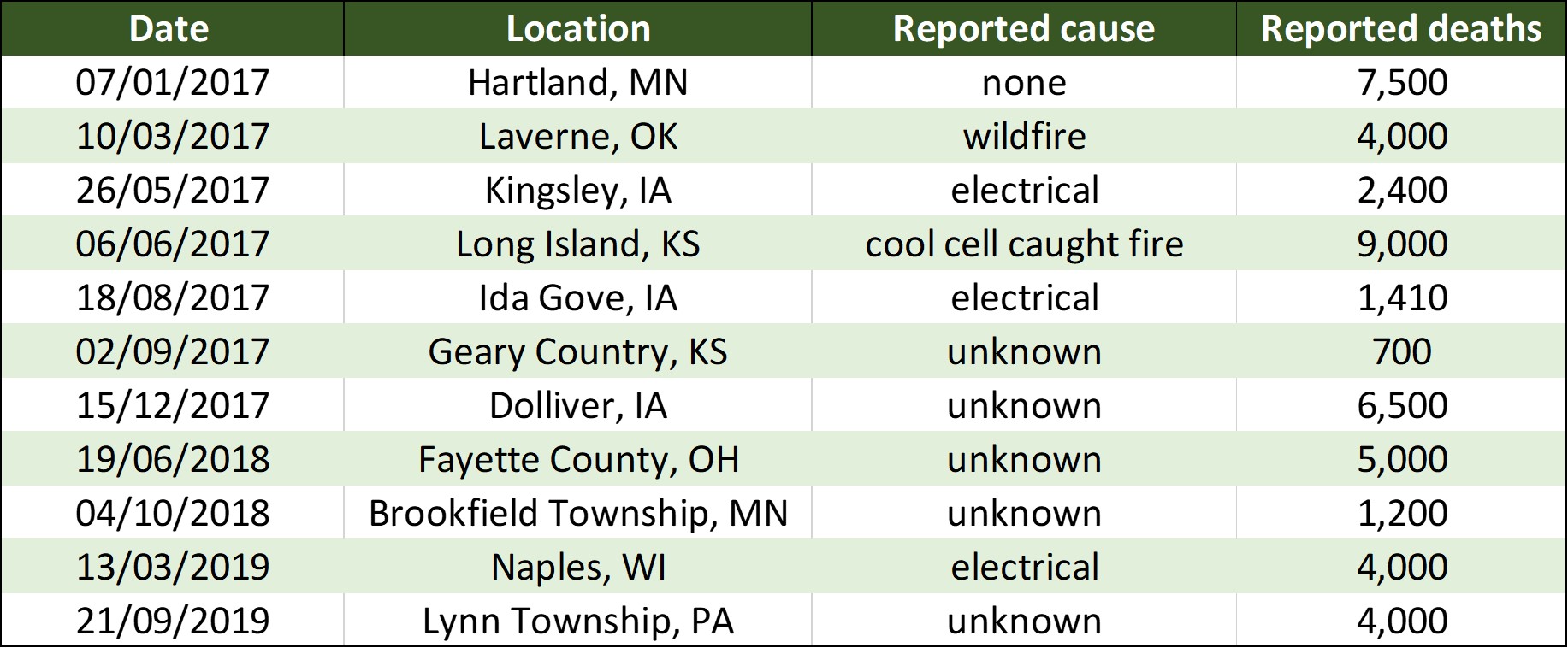



Barn fires: how to address a deadly threat to pigs
It is estimated that between 2013 and 2019, over 86,546 pigs died in barn fires in the US. We speak to the Animal Welfare Institute about what’s needed to protect pigs in the future.In 2018, the Animal Welfare Institute (US) released its official barn fire report which presented a detailed analysis of data compiled from barn fires that occurred between 2013 and 2017 in the US. In those five years, there were 326 deadly barn fires where at least 2,763,924 farm animals died and these numbers are not on the decline.
Catastrophic fires can occur in farms of any size, housing any species of animal, yet in the US there are no federal or state laws designed to protect those animals. There is no obligation to install fire prevention, detection or suppression systems in animal housing which Dena Jones, AWI farm animal programme director, believes is the main reason these fires get out of hand and, in the process, kill millions of animals each year.
“We have to put this into perspective here,” says Dena Jones, AWI farm animal programme director.
“Usually these fires start out very small and if a small fire was to start in any other type of building – whether that be an office, a hospital or school – then it wouldn’t usually spread so quickly and would be controlled before it could spread further. It wouldn’t kill all of the occupants."
So why are ban fires so catastrophic?
“When these fires start, they’re either not detected or detected too late, so they spread very quickly. Add to this the lack of suppression and by the time the fire department get there – usually in the middle of the night – the barn is engulfed and the animals inside will have been lost.
“It can start as just a small event but because of the lack of detection and suppression, the fires are catastrophic.”
Causes of barn fires
In AWI’s 2018 report, research showed that out of 326 fatal barn fires, the cause or likely cause was only reported in 106 cases. The damage generated by fires makes determining the exact cause very difficult. This said, in cases where the cause was known, the majority were electrical faults: heaters, automatic ventilation systems and machinery.

“Heating devices in particular have a higher fire risk and have been responsible for a large proportion of the electrical fires we’ve had reported,” says Dena.
Dena explains that a pattern can be observed in the frequency of fires and their location, and that farms in Northern Europe and Canada are experiencing similar issues.
“Our research indicates that cold weather and confinement are the main links between the frequency and severity of fires in the US.
“Whether these farms are housing poultry, pigs or other species, most reported barn fires occur in colder states (and during the winter months) and the greatest number of animal deaths occur in the larger, intensive farms, primarily in the Upper Midwest, West and Northeast.”

Total (2017-2019): 45,710 pigs*. *The information on barn fires used in the report was obtained through media reports, therefore loss of life is, on occasion, underestimated as the number of deaths are not always reported. All data provided by Animal Welfare Institute 2020. © Animal Welfare Institute
Health and safety for farm staff
Raising awareness of this issue is a primary focus for the Animal Welfare Institute but farm workers should also be proactive in ensuring on-farm safety measures are established
“These fires are a risk for workers as well so if they have any concerns about the practices used on farm, they should feel confident to speak up,” says Dena.
“If they suspect any on-farm practice might be contributing to the risk of fires starting, or that there isn’t enough detection and suppression on farm – even just from a workers' rights perspective – they should speak up.
“It’s in everyone’s best interest to deal with this problem. Even neighbouring houses and communities.”
Regulation and protection for farm animals
Barn fires are a primary focus for the Animal Welfare Institute in 2020 as it is predicted that the frequency and severity of these fires will not drop unless action is taken by authorities to establish on-farm standards that protect the animals inside the barns.
Dena says that the lack of regulation at a local and state level is a contributor to the high death toll when these barn fires occur.
“There are no laws that cover farm animals in barn fires whereas there are protective codes for people and property,” she explains.
“In addition to that, none of our agricultural trade associations have standards (or have very little in terms of standards) that address prevention, detection and suppression.”

Inadequate water costs lives as barns burn faster. This water storage could supply both sprinkler systems and the attending fire authorities.
To minimise the risk of fatal fires AWI recommend the following fire protection methods:
- Install sprinkler systems.
- Install smoke or heat detection systems.
- Install carbon monoxide detectors.
- Request annual inspections from the fire department.
- Place fire extinguishers in barns.
- Institute frequent fire prevention training for employees and routine fire drills.
- Frequently check, repair, and replace heating and other electrical equipment.
They are also urging the trade associations to, as a minimum, adopt the standards of the National Fire Protection Association. The AWI says that it would be a positive step to establish a special code that solely addresses animal welfare.
“If we then go on to draft legislation, we would ask for provisions that cover the three areas previously mentioned.
“Prevention: which should include regular annual inspection from a local fire authority, training of workers and an emergency plan that includes evacuation of animals.
“Detection: accurate smoke detection technology connected to an alarm system that notifies the local fire authority and the farm manager immediately.
“And suppression: sprinklers are costly but are the most effective method of controlling death rates.
“In some rural areas with limited water supply, we’re also advocating the option of on-site water storage. Inadequate water costs lives as barns burn faster. This water storage could supply both sprinkler systems and the attending fire authorities.”
Barn fires represent a significant animal welfare issue, says Dena, and she believes they currently get inadequate attention both from state officials and the public, and with the industry itself. AWI is trying to draw attention to the issue, their priorities being poultry and pigs due to the scale of deaths and the number of fires.









